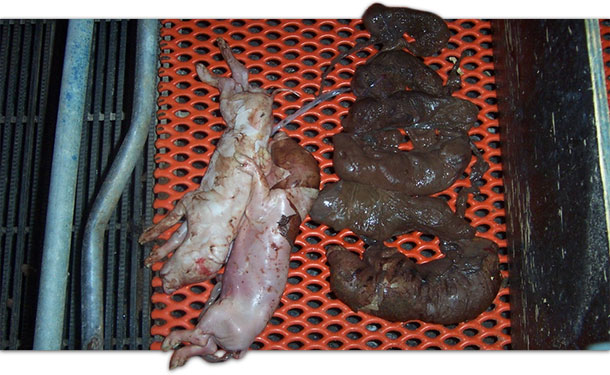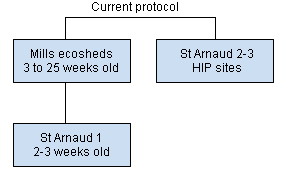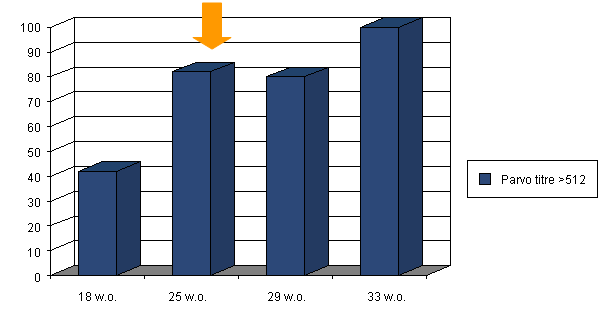The “normal” sporadic and unexplained abortion rate in pigs is approximately 1 to 2 % of pigs that are mated and achieve a pregnancy. The routes of infection of pig foetuses by abortogenic agents such as viruses and bacteria are usually via the bloodstream following an initial septicaemia – this pattern is not different to other livestock, but of course there are more foetal piglets that may be exposed, compared to lambs or calves.
Case introduction

An outbreak of abortions in a multi-site “high health” breeding pig farm system was investigated. The system was located in isolated farm sites in southern Australia. These isolated locations are features of many Australian pig farms, which provide excellent biosecurity. Australia has also remained free of PRRS and several other major infections endemic to Europe and America, so farms are generally clean with a high health status. However, this long period of pig industry isolation and restricted imports of live pigs has also led to a limited pool of modern pig breed genetics.
An increased number of abortion cases were noted at a nucleus multiplier farm known as St Arnaud 2-3, with 5 % of weekly farrowings affected. The affected pigs appeared exclusively in the first parity gilt section of the farm. Examination of affected are represented in this picture – numerous aborted foetuses are clearly mummies and have been dead in utero for some time. The number of piglets expelled is probably a litter of normal size.

This unacceptable level of abortions led to a study of the exact route of breeding pigs around this farm system. The system consisted of nucleus and multiplier herds scattered in widely separate locations.
Pigs intended for the final nucleus multiplier herd known as St Arnaud 2-3, were initially born on a stand-alone nucleus farm, known as St Arnaud 1, 20 km distant. Both these farms were well-established breeding pig farm sites. Before that the young piglets from St Arnaud 1 are weaned at 3 weeks-old and transported 100 km to an isolated and newly populated outdoor “eco-shed” farm, operated by a part-time contract farmer Mr. Mills, until selection for entering the nucleus multiplier herd at 25 weeks-old. Pigs held at the Mills site are all raised on an all-in, all-out basis. This site had never held pigs prior to this pig flow being started.

A chart of this movement of young female pigs (pig flow) in this farm system is shown. The outbreak occurred in the farrowing areas at the St Arnaud 2-3 HIP site.
Young female pig flow chart from farm site to farm site:
Gilt acclimation protocol

They are then selected for breeding at 25 weeks-old and transported back to the more sophisticated St Arnaud 2-3 “high health herd improvement program – HIP” breeding and farrowing site.
On arrival at St Arnaud 2-3 site, they were mixed with other pigs, vaccinated for parvo-lepto-erysipelas and mated, all within the first 2 weeks of arrival. The occurrence of the outbreaks of abortions was largely related to the pigs under the control of one older farm manager.
Analyses and diagnostic

Submission of diagnostic samples was undertaken. Mummified foetuses and other abortion material were generally of poor quality by the time it reached the available laboratory 200 km distant, with no clear results obtained. Even with the best samples, diagnostic success is low in investigations of pig abortions, at around 30 to 40 %.
Blood samples were collected from pigs through the farm system chain and submitted for abortion agents including porcine parvovirus (PPV) titres. PPV is a ubiquitous and persistent organism on most pig farms, often circulating in the weaner/nursery herd. Early exposure prior to mating therefore generally leads to common antibody titres and associated immunity in most herds, with or without vaccination. Sow and older pigs blood test values for PPV would therefore all be expected to be positive. PRRS titres were negative.
However, the results of the PPV blood testing undertaken on this farm system showed a slow and non-universal range of titres in pigs towards the end of their stay at the isolated and new Mills site – see parvo titre chart.

It is clear that the early weaning of piglets to an isolated site with little or no exposure to parvovirus on-site has led to insufficient PPV titres among the breeding pig community. The failure of one farm manager at St Arnaud 2-3 to allow sufficient time for parvovirus vaccine protocols to become effective prior to mating means that newly mated multiplier pigs are becoming pregnant at around the same that they are being exposed to PPV for the first time at St Arnaud 2-3, hence the occurrence of foetal deaths and mummifications.
Gilts do NOT have much innate immunity to breeding area infections and need plenty of preparation and as much quality vaccination protocols and time for them to be properly established.
Conclusion
Vaccination of pregnant or large breeder pigs for common diseases can be difficult in outdoor, open shed situations with large pens and groups of pigs, which may have had limited human handling contact. It is important to establish proper vaccine injection compliance in these situations – making sure that all animals receive the full and proper 2-dose regimen.





